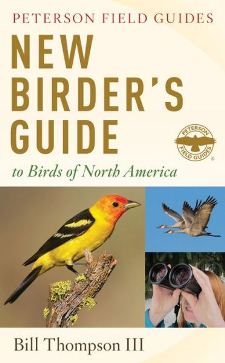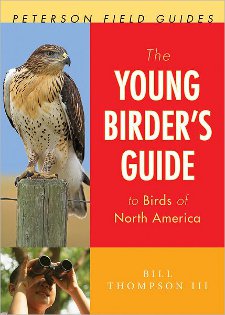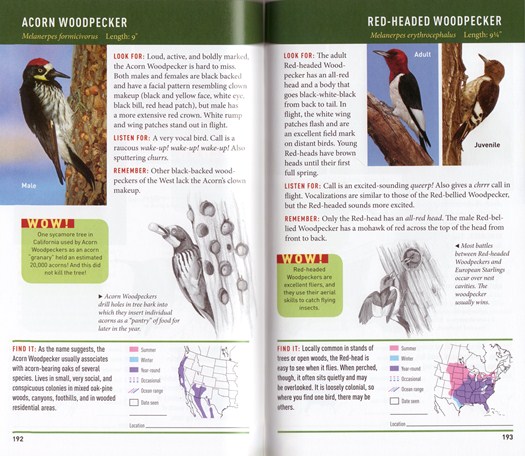Reviewed by Grant McCreary on June 9th, 2014.
New and young birders have never had so many good options when it comes to field guides. Oh, there have long been guides for new and/or young birders – I fondly remember several from my childhood – but I wouldn’t say they were good field guides. They may have served as an introduction to birds and encouraged users to watch them, but their use for identification was problematic at best. Now there are two recent entries in the Peterson Field Guides series – The Young Birder’s Guide to Birds of North America and The New Birder’s Guide to Birds of North America – that seek to provide new and young birders a guide that not only introduces them to the world of birding but is also actually helpful in the field.
The reason this review is covering both field guides is that they are essentially the same book, with just a few modifications. The Young Birder’s Guide was published in 2012 as an updated version of Thompson’s previous The Young Birder’s Guide to Birds of Eastern North America. It added about 100 additional, mostly western, birds, and included some other changes making it appropriate for birders across North America. It was very highly regarded and well-reviewed (and I meant to review it well before now). One of the comments the author got was that it wasn’t just for young birders, any birder could benefit from it. And so, two years later, it has been republished as The New Birder’s Guide. The species accounts are largely untouched (with just a couple photos being replaced). The main difference is in the introduction. Thompson adds about nine pages of material, which I will detail later in the review. Some design elements have also been changed, making it much more attractive now.
Species Accounts
The accounts feature one or two photographs, a range map, text, and a black-and-white drawing. The photos show at most two variations of the bird, whether male/female, breeding/nonbreeding, etc. In contrast to most field guides, the photos are relatively small. I was very surprised by this, especially in a guide that was originally intended for children. But when Thompson was preparing the book, he spent much time with his kids’ elementary school classes, finding out what they preferred in a field guide. Apparently, they favored more text and the other things that were able to be included with a smaller picture. The photos are still large enough to see the bird clearly, so that explanation is good enough for me.
But those aren’t the only illustrations; each account includes a wonderful black-and-white drawing by Julie Zickefoose. These illustrate an interesting aspect of the bird or its behavior. I’ve enjoyed flipping through the guide to appreciate the drawings and read the associated captions. No matter how long you’ve been birding, you’ll learn something. The drawing of a Blue Grosbeak with a large praying mantis in its bill, for instance, caught my attention and I found out that they are “among the few songbirds that will tackle large, aggressive insects such as praying mantises.”
The text includes the following sections:
- Look for – describes what the bird looks like
- Listen for – an excellent, detailed description of the song and call
- Remember – tips for telling the bird apart from similar species
- Find it – habitat
- Wow! – a cool fact about the bird
The text is plainly and clearly written, avoiding the usual jargon found in field guides. Here’s a sample – what to look for on a Yellow-throated Vireo:
The Yellow-throated Vireo adds a pair of yellow spectacles to its attractive yellow-throated attire. Look closely at this species, and it appears to have been dipped head-first in yellow paint, leaving the belly white and the back and tail gray.
That’s a very wordy way of saying to look for yellow spectacles and a sharply demarcated yellow breast and white belly. But it works, giving you a very clear mental picture. Thompson did a great job of tailoring the text to young and new birders by keeping it useful without talking down to them.
Like the drawings, it’s hard to avoid sampling the “Wow” facts. I’d say that some are well known to most birders, some are completely random, many are quite interesting, and a few are corny jokes. Here are a few:
- Least Flycatchers don’t like American Redstarts as neighbors. They regularly chase redstarts (which compete for food) out of their nesting territories.
- The Red-eyed Vireo is the only North American bird with a declarative statement as a Latin name. It means “I am green” in Latin.
- If the Beach Boys had been birders, their hit song might have gone “I wish they all could be California Gulls!”
- One of the Turkey Vulture’s defenses is to puke on an intruder. Trust me: You do not want to get vulture puke on your clothes – you cannot get the smell out!
The range maps use color to indicate summer, winter, and year-round range, with dotted lines to show the extent of occasional occurrence. Oddly, the original Young Birder’s Eastern guide also include migration range on the maps, but that is unfortunately gone now. There’s also a place to check off that you’ve seen the species and write down the date and location.
Introduction
With sections like ‘But Is Birding Cool?’, ‘Be Green: Ten Things You Can Do For Birds’, and ‘You Might Be a Birder If…’ this isn’t your normal field guide introduction. But it’s perfect for new birders. It includes primers on bird identification and optics, but also includes other topics – like gear and appropriate dress – that I remember wondering about when I just started birding. And it’s filled with various tips on how to be a better – and more polite! – birder.
The New Birder’s Guide adds several sections not included in The Young Birder’s Guide, such as ‘Debunking Some Bird Myths’ and ‘Five Outside the Box Tips for Improving Your Birding Skills’. It also greatly expands the discussion of gear.
These guides cover “300 of the most common birds in the United States and Canada.” Species selection is often the biggest issue in guides like these. Include too many and, in the opinion of some, you will overwhelm new birders. But too few will risk users seeing birds that aren’t included in the guide, one of the most frustrating things for new birders. I’m sure that some will find fault with the selection here; there are certainly locally common birds that aren’t included. But overall I’d say it’s a fair collection of species.
Recommendation
I wish that I had The Young Birder’s Guide to Birds of North America when I was a child. It’s both a good introduction to birding and useful for identification. But since it was intended for ages 8-12 (approximately), I was initially concerned that it wouldn’t be appropriate for adults when I heard that it had been turned into The New Birder’s Guide to Birds of North America. But after a closer examination, I don’t think that’s the case; this is a good introductory field guide for new birders of all ages. Everything else being equal, of the two I’d recommend The New Birder’s Guide (even to young birders) since it has an expanded introduction.
Disclosure: I get a small commission for purchases made through links in this post.
Buy from NHBS
(based in the U.K.)
Disclosure: The item reviewed here was a complementary review copy provided by the publisher. But the opinion expressed here is my own, it has not been influenced in any way.








[…] :: From Grant at The Birders Library: Review: The New Birder’s Guide to Birds of North America/The Young Birder’s Guide to north Ameri… […]
[…] :: From Grant at The Birders Library: Review: The New Birder’s Guide to Birds of North America/The Young Birder’s Guide to nor… […]
I was about to think that I’d seen all the regular birds that are aruond my area and have spent the last several vacations looking for birds I’d not seen before. But last week I spotted a Killdeer walking down the sidewalk in our small town. Yesterday, I finally saw a Meadowlark that just perched on my deck just long enough for me to get a good look. That was exciting. My seven year old grandson was with me both times. This got him excited as well about continuing his Life List. He has already this summer identified over twenty birds that he read about in FRIENDS IN THE MEADOW BIRDS, and some others. I framed his Life List certificate he completed from the book and he proudly carried it home to hang on his wall. Not to brag, but he is good. Gets a little carried away sometimes, but that’s o.k. He’ll probably before the summer is over try to convince me he saw the Ivory-billed woodpecker, as he is sure he has seen birds that live on the Pacific coast right here in Alabama! But at least he is excited about bird-watching as is his three year old brother. Keeps them both off the video games and from in front of cartoons all day and into nature and the real world. The best thing is that they love it! The best thing for me is that they are learning about the world and do not realize it, even better!! Happy Birding!!!
[…] recommends guides by Roger Tory Peterson or David Allen Sibley. Stewart specifically suggested The Young Birder’s Guide to Birds of North America by Bill Thompson […]